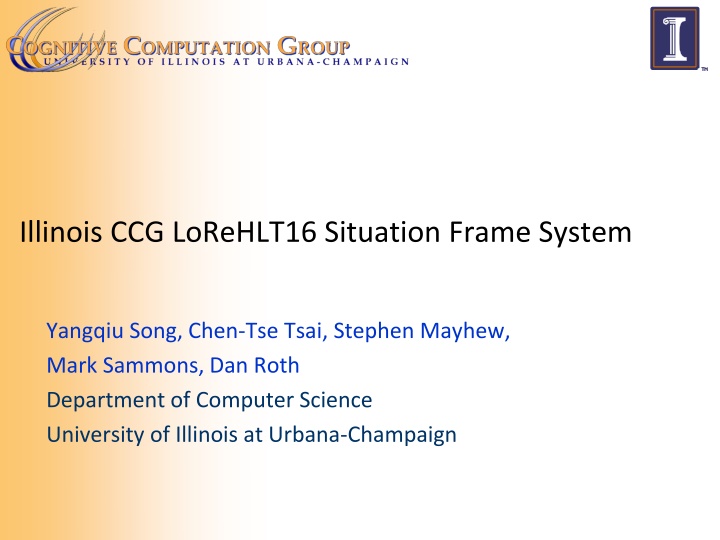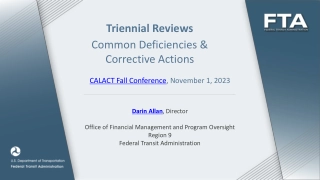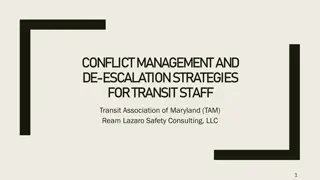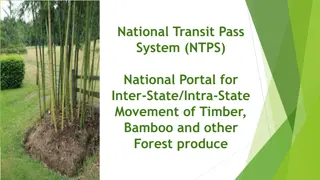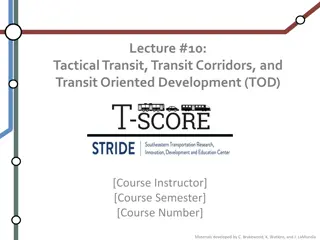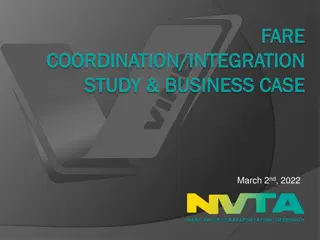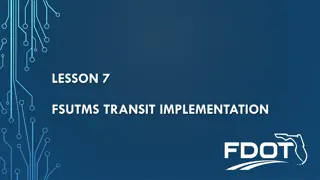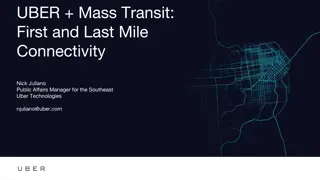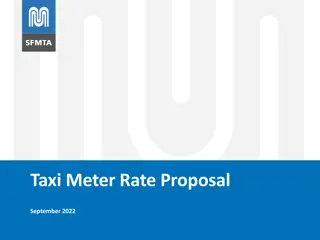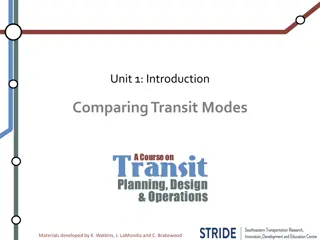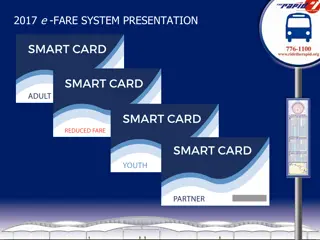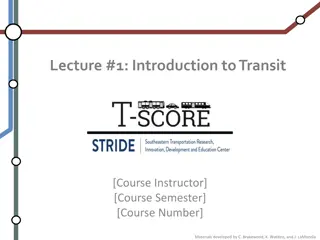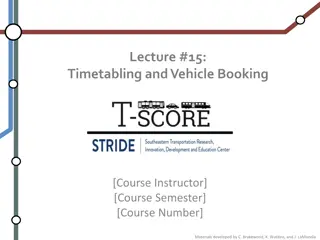Transit Fare Integration Study and Business Case
The study delves into the challenges of current fare policies in transit, emphasizing the importance of coordination and integration to boost ridership. It highlights the disconnect between fare structures and customer value, urging for a coherent set of policies to support ridership growth. Key issues include optimizing fare systems for proposed investments, meeting the needs of Equity Priority Communities, and ensuring future transit equity.
Download Presentation

Please find below an Image/Link to download the presentation.
The content on the website is provided AS IS for your information and personal use only. It may not be sold, licensed, or shared on other websites without obtaining consent from the author.If you encounter any issues during the download, it is possible that the publisher has removed the file from their server.
You are allowed to download the files provided on this website for personal or commercial use, subject to the condition that they are used lawfully. All files are the property of their respective owners.
The content on the website is provided AS IS for your information and personal use only. It may not be sold, licensed, or shared on other websites without obtaining consent from the author.
E N D
Presentation Transcript
Illinois CCG LoReHLT16 Situation Frame System Yangqiu Song, Chen-Tse Tsai, Stephen Mayhew, Mark Sammons, Dan Roth Department of Computer Science University of Illinois at Urbana-Champaign
Overview We focus on two metrics SFType Evaluate (document ID, SF type) SFType + Place Evaluate (document ID, SF type, place mention) Dataless Classification [Chang et al., 2008; Song and Roth, 2014] Build label descriptions Compare similarity between document and labels in Wikipedia title space Page 2
Two Dataless Classifiers Earthquake classifier (Binary) Whether the input text is earthquake related Collect all Wikipedia articles that contain earthquake in the title Use TF-IDF scores to select top 1,000 words as the description SF Type classifier (8 classes) Classify input text into the 8 SF types Use the descriptions of labels in the annotation guideline Page 3
Supervised Classifiers Data Collection Google/Bing/Yahoo: earthquake + SF label names 3,588 documents 1,168 documents after removing documents containing more than one SF label keywords Negative documents 10,000 general documents not related to earthquake in Google News Features are TF-IDF scores of words Earthquake Classifier (80% training, 20% testing) F1: 0.9858 SF Type Classifier (80% training, 20% testing) 3,588 documents Avg F1: 0.5962 (dataless: 0.4953) 1,168 documents Avg F1: 0.6698 Page 4
Cross-Lingual Classification Chinese (Dry run) Use the parallel corpus, directly mapped to English Uyghur Use Uyghur-English dictionary to map each word to English The word-to-word translation we used in NER Page 5
Two Mechanisms Checkpoint 3 Checkpoint 1, 2 Take GPE and LOC mentions from NER Sentence Classification (Binary Classifier) No Is there GPE or LOC in the sentence? Use binary classifier to remove negative examples Yes Use the nearest entity before the sentence Use binary classifier to choose the best entity SF Type classification Output SF Type classification Output Page 6
Results The best score before checkpoint 3 SFType: 1.285 SFType + Place: 1.5 Use NER results from CP1 (29.4 F1) Checkpoint 3 Use NER results from CP3 (60.2 F1) Chinese Uyghur Model Parameter Prec. Rec. F1 SFType+Place SFType SFType+Place Supervised 27.1 16.5 20.5 1.280 5.050 5.299 Dataless 0.002 20.7 23.4 21.9 1.663 3.535 4.065 2.337 Dataless 0.006 20.6 14.1 16.7 1.403 1.929 Dataless 0.010 24.1 12.6 16.5 1.271 1.604 1.896 Dataless 0.014 24.3 10.1 14.3 1.214 1.491 1.694 Page 7
Discussion Entailment is needed Annotators should always create a Need Frame for needs that are explicitly discussed in the document. The needs don t have to be mentioned by name to be included. For instance, if the document says that People haven t eaten in days , then it s obvious that there is a Food Supply need even though the words Food Supply are not used. Annotators should also create a Need Frame if they believe, after reading the document, that the need exists -- even if the document does not directly discuss the need. For instance, the following example contains a Medical Assistance need: Following seasonal monsoons, more than 43,000 people were being treated for diarrhea in Bangladesh, said government health adviser Matiur Rahman. Page 8
Discussion Background knowledge is needed A typhoon has demolished the city of Tacloban. The annotator should create Shelter and Infrastructure Need Frames, Annotators should not go too far with inferring needs that aren t directly discussed or strongly implied by the document. It s entirely plausible that the citizens fled to safety in advance of the incident and that the food and water supply chains in this region are designed to withstand typhoon damage. Therefore, no Need Frames for Food Supply, Water Supply or Medical Assistance should be created for this example. Page 9
Discussion: Place Mention Co-reference is needed For instance, the document might contain the following text in the first paragraph: Eyewitnesses said a landslide hit the village of Guinsaugon in the south of the Philippine island of Leyte. Several paragraphs later, the document may say: Governor Rosette Lerias described the village as totally flattened with virtually all housing destroyed. Guinsaugon is the Place for the Shelter Need Frame This example also highlights the issue of entity granularity for GPE and LOC entities. The village Guinsaugon (GPE) is located on the island Leyte (LOC) in the country Philippines (GPE). The annotator should not create separate Shelter Need Frames for Leyte or the Philippines. Page 10
Discussion: Place Mention Sometimes the place is not mentioned explicitly Eyewitnesses said a landslide hit the village of Guinsaugon in the south of the Philippine island of Leyte. Governor Rosette Lerias described the village as totally flattened with virtually all housing destroyed both in Guinsaugon and in the surrounding region. Besides the Shelter Need Frame with Guinsaugon as the Place, this passage also discusses housing issues in the surrounding region . We know from reading the document that Guinsaugon is located on the island of Leyte. Therefore, we should create another Shelter Need Frame with Leyte as the Place. Page 11
Discussion: Place Mention Sometimes the need exists in multiple places simultaneously A deadly tropical cyclone Nargis, which occurred over the Bay of Bengal, hit five divisions and states -- Ayeyawaddy, Yangon, Bago, Mon and Kayin on May 2 and 3, of which Ayeyawaddy and Yangon inflicted the heaviest casualties and infrastructural damage. Based on this passage, annotators should create separate Infrastructure Need Frames for all of these Places: Ayeyawaddy, Yangon, Bago, Mon, Kayin. Page 12
Conclusion and Discussion Our current system is purely data-driven Observe patterns in the data Leverage external knowledge to enrich the representation Leverage external data (from Google) to build classifiers Annotation has more background knowledge Textual entailment Hierarchy of GPE/LOC Background knowledge about the disasters Human inference process Future work Better IL representation How to incorporate background knowledge and reasoning into models? Page 13
